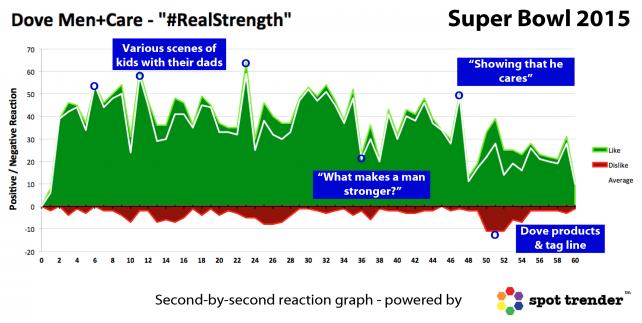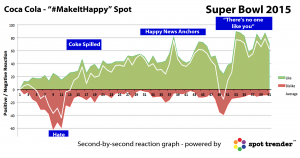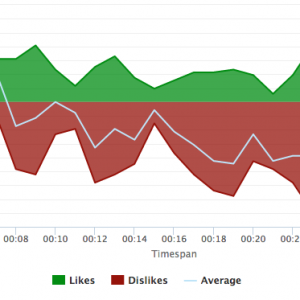Design your Spot’s Emotional Ride
Audience reaction to your spots should work with your objectives, whether you’re looking to build an overall positive feeling for brand or product, or you’re aiming to take your audience on a roller coaster of emotion. Spot Trender reaction graphs measures your audience reaction to your spot as they watch your commercial with reaction graphs. What are reaction graphs? As your target audience watches the video, they click up or down arrow button on the keyboard to indicate whether they like or dislike a section. Respondents also provide live, time-stamped comments as they watch.
To illustrate how reaction graphs work, let’s look at some examples:
Example 1 – Overwhelmingly Positive
Overwhelmingly Positive spots are great to evoke the “warm fuzzies” while your audience watch to associate positive feelings with your brand. Dove Dad Super Bowl. Dove’s #RealStrength Super Bowl 2015 spot is a great example of this. You can see the spot here:

The spot remains consistently positive with few and insignificant negative dips.
Example 2 – Emotional Ride
While some advertisers like viewer reaction to stay positive throughout the spots, others strive to take the audience on an emotional ride, like Coca Cola’s #MakeItHappy spot from Super Bowl 2015.You can view the spot here.

The spot starts negatively, surprises the audience, and shoots up at the end.
Knowing how your target audience feels about your spot every second gives you the unprecedented power and control to design your audience’s emotional ride. For instance, you’re looking to create an Overwhelmingly Positive spot. Let’s say you finished your first round of Story Board Testing, and you saw 1 or 2 negative dips in the middle – or worse, a negative dip at the end of your spot. Instead of blindly produce, run the spot, and hope for good results – you can:
- Look at the section of the video when the negative dips happened, note the content of that segment. For example, was there a joke during that segment? Was there music change, or images displayed during that segment?
- Cross check the “trouble segment(s)” with live verbatims. You’ll very likely see comments such as “this joke is not funny”, “image is not realistic, looked too photoshopped”, or “I don’t like the announcer voice. He sounded too salesy…”
- Change the content. For example, you can cut out the offensive joke, use more believable image, or change the voice-over.
Are you working on a spot, and curious how people would react to your ad? Your current running spot didn’t perform as you expected? Contact Spot Trender—we would be happy to help taking your spots to the next level. Contact us today.








